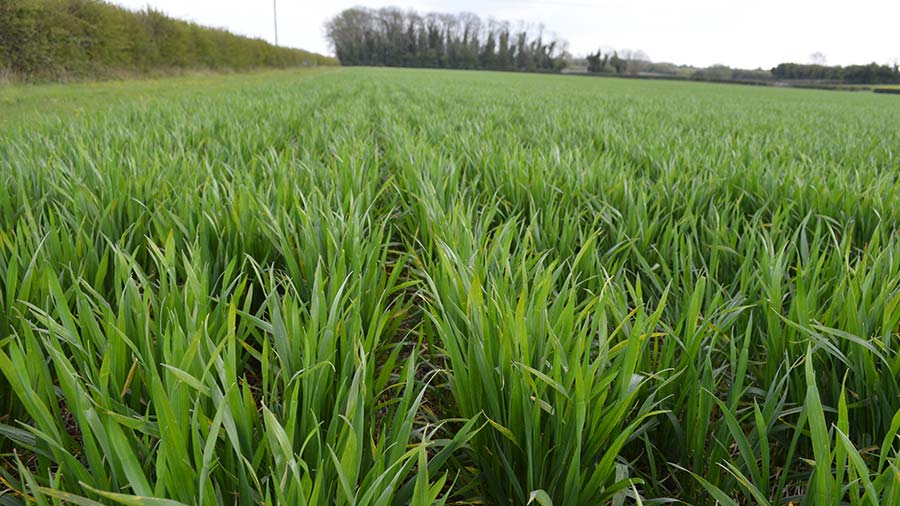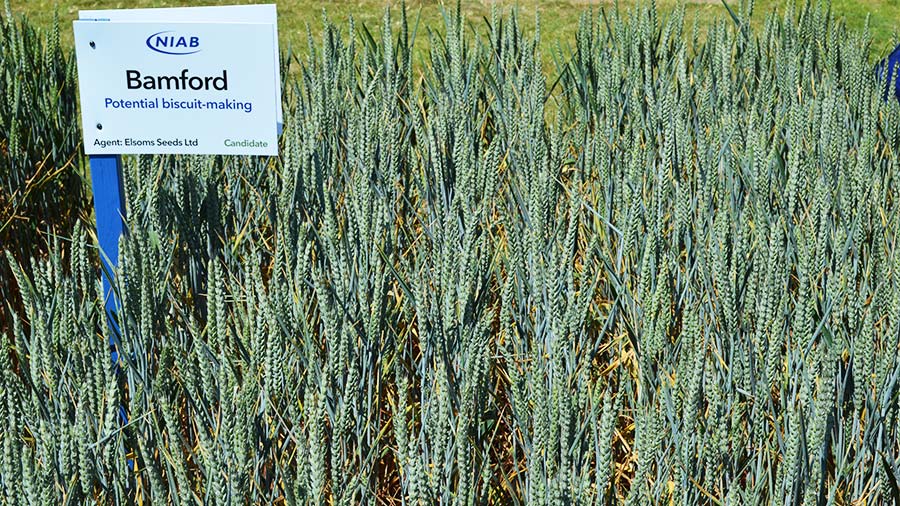New soft wheat looks good for biscuits and distilling
 Bamford winter wheat in late April © MAG/David Jones
Bamford winter wheat in late April © MAG/David Jones New biscuitmaking winter wheat variety Bamford has good support from two seed merchants from the Scottish Borders and Kent for its yield, strong disease resistance ratings and potential good marketability.
The soft-milling Group 3 variety, bred by Elsoms Seeds, comes up for possible inclusion in the new AHDB Recommended List (RL) at the end of this year and is showing good fungicide-treated and untreated yields.
Variety experts say it is one to keep an eye on and an early favourite to gain a place on the RL.
See also: A wheat grower’s 4 tests to get nitrogen application rates spot on
Laura Beaty, seed grain director at McCreath Simpson and Prentice (MSP), has followed the variety’s progress closely through National List 1 and National List 2 trials.
She believes it has wide marketability, with potential to be a key variety in the distilling market.
“With a treated yield of almost 106% supported by a very high untreated yield of 92% – both figures higher than other varieties in its class – Bamford looks to be one of the most exciting varieties going forward onto the 2024 Recommended List later this year,” she says.
Robust wheat
Laura adds that with a disease rating of 7 for septoria and with strong disease resistance to both mildew and yellow rust, it looks robust and should attract growers from all regions within the UK.
Varieties are rated on a 1-9 disease rating system, with 1 being susceptible and 9 showing good resistance.
“Having seen positive reports on the variety’s alcohol yield and residue viscosity conducted by the Scottish Whisky Research Institute at NL2, we can already see Bamford’s commercial promise,” she says.
The variety’s maturity at +1 compared with a 0 for Skyscraper – the most popular wheat variety in Scotland – could help large growers to spread their harvest. Maturity is rated on days later (+) or earlier (-) than Skyfall, which is rated as a 0.
“The next stage will be to await the variety’s entry onto the next RL before we place it with key growers to further evaluate its performance more closely in real farm situations,” she says.

© MAG/David Jones
Disease rating
Another with positive early views on the variety is Andrew Bourne, seed manager for Kent-based merchant T Denne and Sons, who first saw Bamford in NL1 trials on a breeder’s site back in 2021.
“I specifically remember the trials manager singling it out as ‘one to watch’ and you have to make an important mental note in those situations, given it wasn’t actually one of their own varieties,” says Andrew.
He points out the 7 resistance rating for septoria is a standout statistic, but when considering that Bamford is a Moulton-cross, not a Cougar-cross, then the genetic sums begin to add up.
“In our region we still have a lot of growers with Zyatt and Skyfall, both good yielders, but with high susceptibility to yellow rust.
“Bamford’s 7.8 score for yellow rust, combined with its very high yield, could make it a popular choice for the South,” he says.
Andrew points out that on out-and-out yield it’s challenging the best of the Group 4 feed wheats, and has potential to become another Riband or Consort.
These were two highly successful varieties that came out of the Plant Breeding Institute programme in the 1990s.
Neither were the most popular varieties because they were Group 3s, they simply had a good combination of high yield, excellent disease resistance and consistency.
“Bamford is not only the most competitive Group 3 variety at this stage, it has the potential to become one of the most competitive and marketable soft wheats in the market with suitability for biscuitmaking, export and distilling.
“With that kind of market flexibility, it certainly looks to be one of the most exciting NL candidate varieties on this year’s list,” he says.

